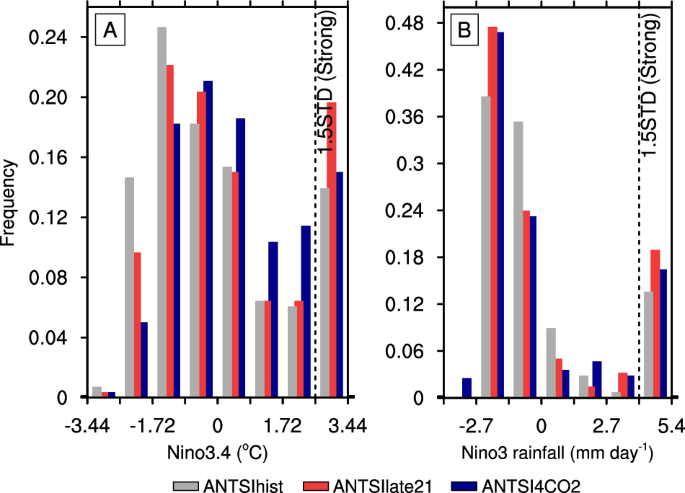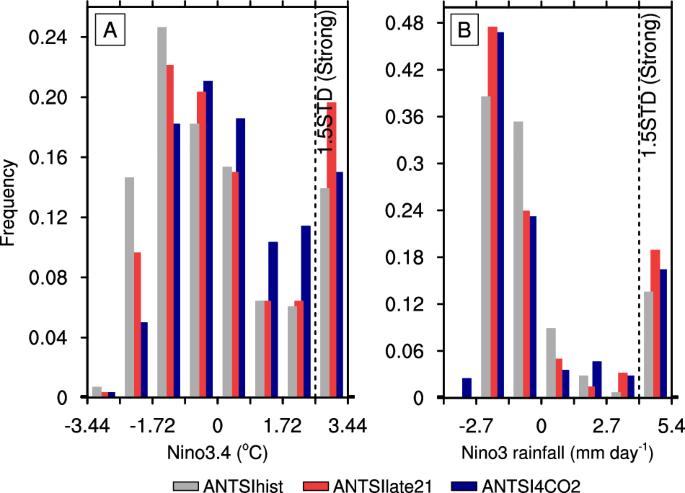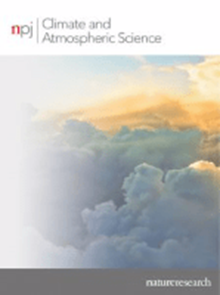Projected Antarctic sea ice change contributes to increased occurrence of strong El Niño
IF 8.4
1区 地球科学
Q1 METEOROLOGY & ATMOSPHERIC SCIENCES
引用次数: 0
Abstract
Current climate models suggested that Antarctic sea ice cover would decrease substantially under cumulative CO2 emission, but little is known whether large decrease in Antarctic sea ice can influence the occurrence of strong El Niño. Using time slice coupled and uncoupled model experiments, we show that in response to half reduction of Antarctic sea ice projected near the end of the 21st century, the frequency of strong El Niño would be increased by ~40%. It is contributed by enhanced thermocline, Ekman, and zonal advective positive feedbacks that are partly offset by enhanced thermodynamic damping. The strong warming and weakened westerly winds in the southeastern Pacific generate an anomalous Rossby wave propagating into the eastern subtropical and tropical Pacific, favoring stronger El Nino, and air-sea coupling and ocean feedbacks play a critical role in the teleconnection. Unexpectedly, compare to halved Antarctic sea ice, the ice-free Antarctic leads to a decrease in the frequency of strong El Niño, which is largely due to a substantial increase in thermodynamic damping. We also show that a large portion of the increase of strong El Niño events under greenhouse warming might be connected with Antarctic sea-ice loss, though increased greenhouse gas plays an important role.


预计南极海冰变化导致强厄尔尼诺现象增多
目前的气候模式表明,在二氧化碳累积排放的情况下,南极海冰覆盖面积将大幅减少,但人们对南极海冰的大幅减少是否会影响强厄尔尼诺现象的发生知之甚少。利用时间片耦合和非耦合模式实验,我们发现,在 21 世纪末南极海冰预计减少一半的情况下,强厄尔尼诺现象的发生频率将增加约 40%。其原因是热层、埃克曼和带状平流正反馈增强,而热力学阻尼增强则部分抵消了这些正反馈。东南太平洋的强烈升温和减弱的西风产生了异常的罗斯比波,传播到亚热带和热带太平洋东部,有利于厄尔尼诺现象的加强,海气耦合和海洋反馈在远距离联系中发挥了关键作用。意想不到的是,与南极海冰减半相比,南极无冰导致强厄尔尼诺现象发生频率降低,这主要是由于热力学阻尼大幅增加。我们还表明,温室效应下强厄尔尼诺现象的增加很大一部分可能与南极海冰的减少有关,尽管温室气体的增加也起了重要作用。
本文章由计算机程序翻译,如有差异,请以英文原文为准。
求助全文
约1分钟内获得全文
求助全文
来源期刊

npj Climate and Atmospheric Science
Earth and Planetary Sciences-Atmospheric Science
CiteScore
8.80
自引率
3.30%
发文量
87
审稿时长
21 weeks
期刊介绍:
npj Climate and Atmospheric Science is an open-access journal encompassing the relevant physical, chemical, and biological aspects of atmospheric and climate science. The journal places particular emphasis on regional studies that unveil new insights into specific localities, including examinations of local atmospheric composition, such as aerosols.
The range of topics covered by the journal includes climate dynamics, climate variability, weather and climate prediction, climate change, ocean dynamics, weather extremes, air pollution, atmospheric chemistry (including aerosols), the hydrological cycle, and atmosphere–ocean and atmosphere–land interactions. The journal welcomes studies employing a diverse array of methods, including numerical and statistical modeling, the development and application of in situ observational techniques, remote sensing, and the development or evaluation of new reanalyses.
 求助内容:
求助内容: 应助结果提醒方式:
应助结果提醒方式:


